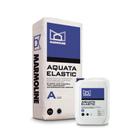Problem
Several times in the interior masonry we find thin, almost imperceptible cracks, known as capillary cracks. One of the reasons for these small imperceptible cracks in the plaster is the penetration of rising moisture.
Rising humidity can cause problems, both in the structural elements of the building and in its functionality (unpleasant living conditions, odour, etc.).
Application steps
The substrate should be clean, free of foreign particles and structurally even without cracks. Loose plasters should be removed. The temperature of the substrate should be between 5 ° C and 35 ° C. Pour the liquid (comp. B) of MARMOLINE AQUATA ELASTIC into a clean container, leaving a small amount in the container. The powder (comp.A) should be added slowly to the liquid while stirring with a suitable mixer . The material is applied in two layers. Apply the first layer with a brush by pressing the material to the surface and a second layer can be applied (with a brush, spatula or roller) when the first has dried and always crosswise.
Plastering
We apply the base coat plaster of high strength of MARMOLINE SV 1 in thickness up to 4mm. Then, when the SV1 has dried, we continue with the application of the final one-layer plaster of MARMOLINE SV 60 which is suitable for thickness up to 2.5 cm or MARMOLINE BP 115 for thickness up to 2 cm or the ultra-white MARMOLINE SV 100 also for the same thickness.
Then, we proceed with the priming of the surface, applying the water primer MST 11 of MARMOLINE, diluted up to 30% with water. Wait about 2 hours for it to dry. Then and depending on the use, indoor or outdoor, we choose either the MARMOLINE FLYING COLORS with a coverage of approximately 12-14 m 2 / lt depending on the substrate.
ΤΙPS
- The application is not recommended when intense weather conditions of heat, humidity, rain, air are observed (to avoid any adhesion of dust to the fresh paint).
- The application of paints, as well as all materials must be carried out in a temperature range from 5 ° C to 35 ° C.

